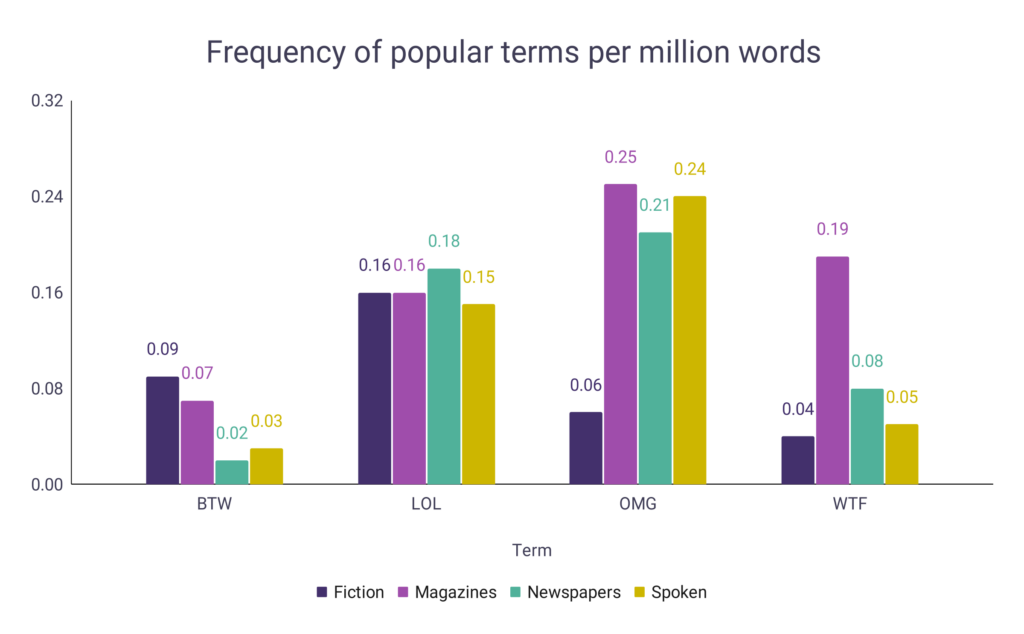As a key component of language, acronyms allow us to make multiple words into a shorter, more memorable term. In this article, WordsRated looks at some of the most common acronyms across the business, medical and military fields, in addition those used for text-based messages.
- In a study of scientific articles, acronyms were found to have been used at least once in 19% of titles and at least once in 73% of abstracts.
- Although scientific acronym usage was shown to increase over time between 1950 and 2019, the re-use of acronyms in articles declined.
- Only 0.2% of scientific acronyms were found to be used with regularity.
- 54% of acronyms in a 13,683 item corpus were found to be proper nouns, compared to only 13% of abbreviations.
- Two of the oldest acronyms known to us have origins in Christianity.
- Early Christians referred to Christ as ΙΧΘΥΣ (meaning “fish” in ancient Greek), with its letters standing for “Jesus Christ, Son of God, Savior”.
- Furthermore, INRI (“Iesus Nazarenus Rex Iudeaeorum” in Latin) was marked on the cross of Jesus’ crucifixion, which stood for “Jesus of Nazareth, King of the Jews”.
- The extremely popular 3-letter acronym LOL (meaning laugh out loud) was first entered into The Oxford English Dictionary in March 2011.
- Its oldest recorded usage as an acronym with the same contemporary meaning is believed to be a typed message in the 1980s.
- One 2019 study suggests that when individuals wish to join a social group, they adjust their language to fit in, which includes the learning of acronyms.
- Due to this, knowledge of relevant acronyms can have a positive impact on a person’s status within social circles.
A number of acronyms feature in our WordLists, which allow you to search for new terms based upon the letters they include and their total letter count. However, our word finder can give you further help in a variety of word games to find the perfect word to play in time for your next move!
Common business acronyms
In a business environment, acronyms allow us to simplify communication by breaking down word groups or concepts into a short grouping of characters. This allows professionals to quickly and easily share information, aiding comprehension in a fast-paced setting.
| Term* | Meaning |
| B2B | Business-To-Business |
| B2C | Business-To-Consumer |
| CAC | Customer Acquisition Cost |
| CEO | Chief Executive Officer |
| CRM | Customer Relationship Management |
| CSR | Corporate Social Responsibility |
| CTA | Call To Action |
| CTR | Click-Through Rate |
| EOD | End Of Day |
| ETA | Estimated Time Of Arrival |
| HR | Human Resources |
| IPO | Initial Public Offering |
| KPI | Key Performance Indicator |
| NDA | Non-Disclosure Agreement |
| P&L | Profit And Loss |
| R&D | Research And Development |
| ROI | Return On Investment |
| SAAS | Software As A Service |
| SWOT | Strengths, Weaknesses, Opportunities, Threats |
| USP | Unique Selling Proposition |
Common medical acronyms
The simplification and standardization of communication in the medical field is of extreme importance. Utilizing acronyms allows healthcare professionals to enhance precision, lowering their risk of error and allowing for a smoother flow of information.
| Term* | Meaning** |
| AIDS | Acquired Immunodeficiency Syndrome |
| CBC | Complete Blood Count |
| CDC | Centers For Disease Control And Prevention |
| CPR | Cardiopulmonary Resuscitation |
| CT | Computed Tomography |
| DNA | Deoxyribonucleic Acid |
| ECG/EKG | Electrocardiogram |
| ER | Emergency Room |
| FDA | Food And Drug Administration |
| GERD | Gastroesophageal Reflux Disease |
| HIPAA | Health Insurance Portability And Accountability Act |
| HIV | Human Immunodeficiency Virus |
| ICU | Intensive Care Unit |
| IV | Intravenous |
| MRI | Magnetic Resonance Imaging |
| NPO | Nothing By Mouth (Latin: Nihil Per Os) |
| OB/GYN | Obstetrics And Gynecology |
| PCR | Polymerase Chain Reaction |
| RA | Rheumatoid Arthritis |
| UTI | Urinary Tract Infection |
Common military acronyms
In a military setting, communication needs to be clear and quick, which is especially relevant during battlefield life-or-death situations. Acronyms allow the military to streamline the flow of information, so that decision-making becomes second-nature.
| Term* | Meaning** |
| AFB | Air Force Base |
| AWOL | Absent Without Leave |
| BCT | Basic Combat Training |
| CO | Commanding Officer |
| DCU | Desert Camouflage Uniform |
| DOD | Department Of Defense |
| IED | Improvised Explosive Device |
| KIA | Killed In Action |
| MIA | Missing In Action |
| MOS | Military Occupational Specialty |
| NCO | Non-Commissioned Officer |
| OEF | Operation Enduring Freedom |
| OPSEC | Operational Security |
| PCS | Permanent Change Of Station |
| POW | Prisoner Of War |
| PT | Physical Training |
| ROE | Rules Of Engagement |
| SOP | Standard Operating Procedure |
| VFW | Veterans Of Foreign Wars |
| WMD | Weapons Of Mass Destruction |
Common text acronyms
As an alternate method of communication, text-based messages are often intended to be casual and less detailed. An increased usage of acronyms can allow the conversation to flow more rapidly between participants, whilst also saving time on keystrokes for each user.
| Term* | Meaning |
| AFK | Away From Keyboard |
| BFF | Best Friends Forever |
| BRB | Be Right Back |
| BTW | By The Way |
| DM | Direct Message |
| FTW | For The Win |
| FYI | For Your Information |
| GTG | Got To Go |
| ICYDK | In Case You Didn’t Know |
| ICYMI | In Case You Missed It |
| IDK | I Don’t Know |
| IMO | In My Opinion |
| LOL | Laugh Out Loud |
| NSFW | Not Safe For Work |
| OMG | Oh My God |
| ROFL | Rolling On The Floor Laughing |
| SMH | Shaking My Head |
| TL;DR | Too Long Didn’t Read |
| TTYL | Talk To You Later |
| WTF | What The F*** |
Frequency of text acronyms and initialisms
- A 2012 study compared the usage of common acronyms and initialisms per million words across various formats.
- Across all formats, “FYI” was the most popular term, appearing more than twice as frequently as the other given four terms combined.
- “OMG” rarely appears in fiction and is significantly more common in other formats.
- “LOL” shows little variance between all four formats.
- “WTF” appears in magazines over 2x more than in any other format.
- “BTW” is a more popular term in fiction and magazines, with its usage dropping in newspapers and spoken word.
Popular terms per million words
| Term | Fiction | Magazines | Newspapers | Spoken | Total |
| BTW | 0.09 | 0.07 | 0.02 | 0.03 | 0.21 |
| FYI | 0.20 | 2.75 | 0.80 | 0.25 | 4.00 |
| LOL | 0.16 | 0.16 | 0.18 | 0.15 | 0.65 |
| OMG | 0.06 | 0.25 | 0.21 | 0.24 | 0.76 |
| WTF | 0.04 | 0.19 | 0.08 | 0.05 | 0.36 |
A graph is given below to show the frequency of popular terms per million words (excludes “FYI”):

A graph is given below to show the frequency of “FYI” per million words:

Acronyms FAQ
What is an acronym?
- An acronym is a term created by joining together the starting letters of different terms.
- Sometimes supplementary letters will also be included from the original terms used.
- With acronyms, the term is typically pronounced as a single word, rather than as independent letters.
- Examples of acronyms include:
- PIN (personal identification number)
- RADAR (radio detection and ranging)
- SCUBA (self-contained underwater breathing apparatus)
What is an initialism?
- An initialism (or alphabetism) is a type of abbreviation made up of the starting letters of different terms.
- However, with initialisms, each letter should be pronounced individually, rather than as a single word.
- Examples of initialisms include:
- “FAQ” (frequently asked questions)
- “FYI” (for your information)
- “TBA” (to be announced)
What is an abbreviation?
- An abbreviation is created by shortening a term or phrase.
- Both acronyms and initialisms also fall under the bracket of abbreviations.
- Excluding acronyms and initialisms, examples of abbreviations include:
- Cal (calorie)
- Kg (kilogram)
- Mr. (Mister)

